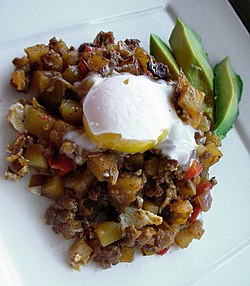Coddling

In cooking, to coddle food is to heat it in water kept just below the boiling point.[1] In the past, recipes called for coddling fruit,[2] but in recent times the term is usually only applied to coddled eggs.[3] Coddling differs from poaching in that the coddled ingredient is not placed directly in hot water, but instead in a small dish placed in a hot water bath. [4] The process is either done in a regular pan or pot filled with water, either on the stovetop or placed in the oven,[4] or through the use of a special device such as an "egg coddler" (originally known as a pipkin).[5] The oven technique is similar to the preparation of baked eggs, the difference being that the preparation of baked eggs does not have to employ a water bath.[4]
The word coddle evolved from the name of a warm drink, "caudle", and ultimately deriving from the Latin word for warm drink, calidium.[6]
Comparing the coddling cooking technique to boiling when it comes to whole eggs, the process of coddling takes a longer time due to the use of a lower cooking temperature, but it produces a more tender egg.[7]
See also
[edit]References
[edit]- ^ Kipfer, Barbara Ann (2012). The Culinarian: a Kitchen Desk Reference. Hoboken, N.J.: John Wiley & Sons. p. 137. ISBN 9780470554241.
- ^ Hess, Karen (transc) (1981). Martha Washington's Booke of Cookery; and Booke of Sweetmeats. New York: Columbia University Press. pp. 96, 239. ISBN 0231049307.
- ^ "Restodontê | Descubra receitas a partir de seus ingredientes". Restodontê (in Brazilian Portuguese). Retrieved 2018-03-17.
- ^ a b c Alfaro, Danilo. "How to Gently Cook Coddled Eggs". The Spruce Eats. Retrieved 3 August 2022.
- ^ Stradley, Linda (2004). "Coddled Eggs". What's Cooking America. Retrieved 28 February 2014.
- ^ Online Etymology Dictionary. "Coddle". Douglas Harper. Retrieved 27 November 2012.
- ^ "Coddled Eggs". RecipeTips.com. Retrieved 28 February 2014.
